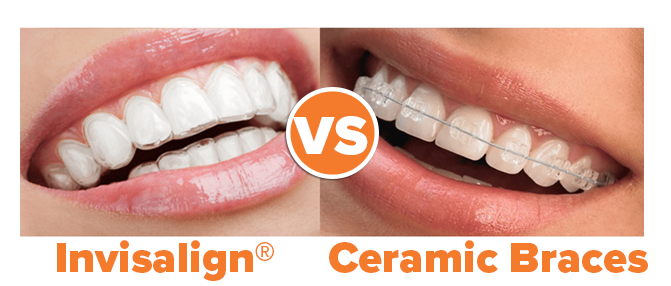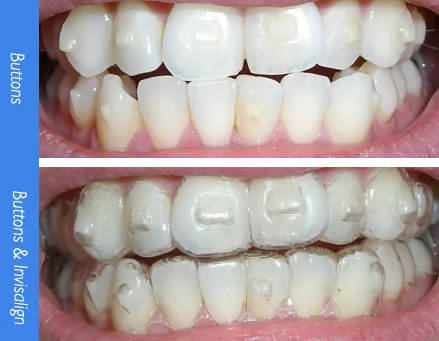Invisalign vs. Traditional Braces: Which Choice Is Right for You?
When thinking about orthodontic therapy, the selection in between Invisalign and traditional braces provides numerous vital factors that merit careful assessment. Invisalign provides a very discreet option with detachable aligners, while typical dental braces give an extra noticeable yet reliable solution for extreme imbalance. Each alternative incorporates distinctive advantages and drawbacks associated with appearances, convenience, therapy period, and expense. Comprehending these nuances is important for making a notified decision that aligns with your individual preferences and way of life. The concern stays: which option will best fulfill your orthodontic demands and assumptions?
Overview of Therapy Options

On the other hand, typical braces consist of steel brackets and cords that are bound to the teeth. This approach uses continual stress with time to achieve alignment. While efficient for complicated orthodontic problems, conventional braces call for normal check outs for adjustments and can present obstacles in preserving dental hygiene as a result of the difficulty of cleaning up about braces and wires.
Both alternatives have their qualities, and the selection commonly rests on certain oral problems, way of life choices, and person conformity. Eventually, getting in touch with an orthodontic professional is essential for identifying one of the most suitable treatment strategy tailored to individual needs. Comprehending the subtleties of each alternative can dramatically affect the total success of orthodontic treatment.
Visual Considerations
A considerable aspect affecting the selection between Invisalign and standard braces is the visual appeal each treatment uses. Invisalign aligners are crafted from clear plastic, making them basically unseen when used.
On the other hand, typical braces consist of metal brackets and cords, which can be extra visible. While improvements in orthodontic technology have actually caused the growth of smaller sized brackets and tinted elastics, standard braces still keep a more noticeable account. For some individuals, the presence of braces may hinder them from seeking needed therapy.
Ultimately, the option in between Invisalign and typical braces might hinge on personal choices regarding aesthetics. Individuals who focus on discretion typically lean towards Invisalign, while those who are less concerned about presence might select standard dental braces. Recognizing the aesthetic ramifications of each choice is critical for making an informed decision that lines up with one's way of living and choices.
Convenience and Convenience

In regards to comfort, Invisalign aligners are removable, enabling individuals to enjoy their favorite foods without constraint and preserve optimal oral hygiene. Cleaning and flossing are simplified, as the aligners can be taken out throughout these routines, whereas traditional dental braces require mindful navigating around braces and cables.
Additionally, Invisalign's dynamic system enables fewer orthodontic brows through. Patients normally receive numerous sets of aligners at the same time, which can enhance the treatment procedure and reduce time spent in the orthodontist's chair. On the other hand, conventional dental braces necessitate normal adjustments, making them much less convenient for those with busy timetables. Invisalign. In general, the convenience and benefit of Invisalign make it an enticing choice for lots of individuals seeking orthodontic treatment.
Therapy Duration and Effectiveness
While both Invisalign and standard dental braces work in fixing oral imbalances, the duration of treatment can vary dramatically in between the two options. Typically, Invisalign therapy can take anywhere from 12 to 18 months, depending on the complexity of the case. The clear aligners work by slowly moving teeth right into their wanted settings, and routine follow-ups with an orthodontist aid make certain progression remains on track.
In contrast, conventional braces often need a longer commitment, typically ranging from 18 months to three years. This is because of their fixed nature and the use of cords and braces, which can be extra reliable for intricate instances and extreme imbalances (Invisalign). The therapy efficiency of conventional braces is well-documented, as they permit precise changes and higher control over tooth movement
Eventually, the selection in between Invisalign and typical dental braces may rest on both the anticipated treatment period and the certain dental issues available. Consulting with an orthodontist is vital, as they can supply tailored recommendations based upon private requirements, guaranteeing the chosen technique aligns with desired timeframes and end results.
Expense Comparison and Insurance Coverage Choices
Cost plays a substantial function in the decision-making process for people thinking about orthodontic therapy, whether choosing Invisalign or standard braces. On average, the expense of Invisalign ranges from $3,000 to $8,000, while typical braces typically set you back between $2,000 and try these out $6,000. Factors affecting these expenses consist of the complexity of the instance, the duration of therapy, and geographical location.
Numerous oral insurance policy plans give partial coverage for orthodontic treatments, however the specifics can differ extensively. Generally, conventional braces might be much more often covered by insurance policy strategies contrasted to Invisalign, which some insurers categorize as a cosmetic procedure.
Furthermore, several orthodontic methods use versatile settlement strategies, making both therapy alternatives extra accessible. Patients must ask about prospective funding choices and discount rates for in advance repayments. Find Out More Evaluating the total cost, including insurance advantages and settlement strategies, is crucial for making an educated decision that aligns with both aesthetic preferences and budget plan considerations.
Final Thought
In summary, the option between Invisalign and conventional braces rests on numerous variables, including aesthetic preferences, convenience, therapy duration, and cost. Invisalign offers a very discreet, detachable choice that promotes dental health and dietary flexibility, while typical dental braces may be better for intricate oral problems and typically come at a reduced cost point. Inevitably, appointment with an orthodontist is necessary to evaluate private situations and determine one of the most suitable treatment alternative for achieving optimum dental alignment.
When considering orthodontic therapy, the option in between Invisalign and standard braces offers several vital elements that merit mindful analysis.Contrasting Invisalign and typical braces reveals unique treatment alternatives for orthodontic modification.While both Invisalign and traditional braces are reliable in fixing oral misalignments, the period of therapy can vary substantially between the 2 alternatives.Expense plays a substantial role in the decision-making process for people considering orthodontic treatment, whether choosing for Invisalign or typical braces.In recap, the selection between Invisalign and conventional dental braces pivots on multiple aspects, consisting of aesthetic preferences, comfort, therapy period, and cost.
Comments on “Success Stories: How Invisalign Changed Lives and Enhanced Confidence”